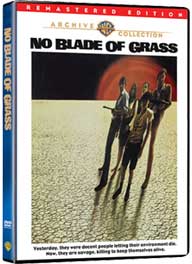 NO
BLADE OF GRASS (1970)
NO
BLADE OF GRASS (1970)Director: Cornel Wilde
Warner Bros. Archive Collection
 NO
BLADE OF GRASS (1970)
NO
BLADE OF GRASS (1970)Veteran Hollywood actor and director Cornel Wilde (THE NAKED PREY) took a great interest in Samuel Youd’s (under the nom de plume “John Christopher”) novel No Blade of Grass, envisioning it as making for an interesting and thought-provoking motion picture. Discovering that the rights to the property belonged to Metro-Goldwyn-Mayer (who apparently sat on it for a number of years), he convinced the studio to let him produce and direct it himself, resulting in what many look upon as an update of Ray Milland’s PANIC IN YEAR ZERO, filmed nearly a decade earlier.
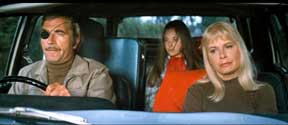
Reports confirm that as a result of pollution and man's mistreating of the environment, a mysterious new virus has surfaced, having a drastic effect on the world’s grasses, including wheat and rice. As famine is now upon the city, a London archeologist named John Custance (Nigel Davenport, PHASE IV) takes his wife (Jean Wallace, wife of director Wilde), their 16-year-old daughter (Lynne Frederick, VAMPIRE CIRCUS), her scientist boyfriend Roger (John Hamill, TOWER OF EVIL) take off in two cars to his brother’s secluded house in the Scottish country. Picking up their young son and his abandoned classmate at boarding school along the way, they also team with a headstrong young gun shop worker named Pirrie (Anthony May, MURDER BY DECREE) who has no problem shooting the shop’s disobliging owner (George Coulouris, THE WOMAN EATER) to show his loyalty to John’s and his traveling troop. Pirrie’s flirty young bride Clara (Wendy Richard, later of “Are You Being Served?” Britcom fame) is also along for the journey, with the bickering couple always at each other’s throats.
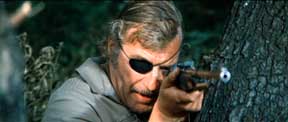 With
plenty of guns and ammunition at hand and three automobiles to take them were
they need to go, they still have to deal with a crumbling civilization of looters,
rioters and rapists (as two of the women unfortunately soon encounter). After
they are ambushed and stripped of their transportation, weapons (which they’re
able to acquire more soon enough) and food, they’re forced to continue
their journey on foot. With John continuing to be the self-appointed leader,
they later run into a larger group of hiking trekkers, and after Pirrie shoots
their leader for insulting him and pointing his rifle at him, they all join
forces and continue to head for the brother’s (Patrick Holt) farmhouse.
After a turbulent run-in with a leather-clad, bull-horned helmeted biker gang
(which calls for a number of casualties), they finally reach their destination,
but the greeting they receive isn’t the friendly one anticipated.
With
plenty of guns and ammunition at hand and three automobiles to take them were
they need to go, they still have to deal with a crumbling civilization of looters,
rioters and rapists (as two of the women unfortunately soon encounter). After
they are ambushed and stripped of their transportation, weapons (which they’re
able to acquire more soon enough) and food, they’re forced to continue
their journey on foot. With John continuing to be the self-appointed leader,
they later run into a larger group of hiking trekkers, and after Pirrie shoots
their leader for insulting him and pointing his rifle at him, they all join
forces and continue to head for the brother’s (Patrick Holt) farmhouse.
After a turbulent run-in with a leather-clad, bull-horned helmeted biker gang
(which calls for a number of casualties), they finally reach their destination,
but the greeting they receive isn’t the friendly one anticipated.
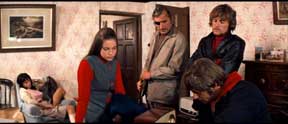
Director Cornel Wilde approached the project as being contemporary in fact and feeling, with pollution being the piece’s villain. In an essay he wrote about the film for Danny Peary’s book Screen Flights/Screen Fantasies: The Future According to Science Fiction Cinema, he wrote, “When I read No Blade of Grass, I saw the opportunity to use it as the basis for a powerful adventure film with an ecological warning to the world”. Although some look upon the film as rubbish, its bleak vision and Wilde’s tactic of not sugar-coating any of the characters or occurrences within makes the movie still poignant and more importantly, wildly entertaining 40 years on, even if it does tend to bear a very dated early 1970s look (which we love anyway). There's a variety of different filmmaking techniques, including the repeated use of flashbacks and flash forwards, quick shots of color reversal as well as the use of still photos to illustrate one of the more dramatic bits. These styles tend to be kitsch rather than innovative when looked at today, but at the same time help separate it from your average piece of post-apocalyptic cinema.
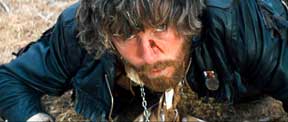 Beginning
with opening stock footage shots of over-population and natural and unnatural
disasters (similar to the start of SOYLENT GREEN three years later) and a hauntingly
somber theme sung by Roger Whittaker, NO BLADE OF GRASS never shies from using
shock value to get its point across. Shots of dead animals (though the end titles
assures that no living thing was killed during the making), newsreel footage
of starving African children juxtaposed against a pub of roast-indulging Britishers
and even a graphic childbirth (shot specifically for the film) are thrown into
the mix. Graphic violence is not too extreme, though the aforementioned rape
scene results in violent revenge and there are plenty of shootings, the most
effective being when a rifle-yielding woman in a farmhouse is blasted, resulting
in a burst of fabricated blood spurting towards the camera lens. As it certainly
fits the 1970s “savage cinema” category, the film is never boring
and the action is well handled, especially a pivotal scene where a biker gang
attempts to ambush the “heroes” who take cover behind large rocks,
resulting in a western-style shootout between the two parties.
Beginning
with opening stock footage shots of over-population and natural and unnatural
disasters (similar to the start of SOYLENT GREEN three years later) and a hauntingly
somber theme sung by Roger Whittaker, NO BLADE OF GRASS never shies from using
shock value to get its point across. Shots of dead animals (though the end titles
assures that no living thing was killed during the making), newsreel footage
of starving African children juxtaposed against a pub of roast-indulging Britishers
and even a graphic childbirth (shot specifically for the film) are thrown into
the mix. Graphic violence is not too extreme, though the aforementioned rape
scene results in violent revenge and there are plenty of shootings, the most
effective being when a rifle-yielding woman in a farmhouse is blasted, resulting
in a burst of fabricated blood spurting towards the camera lens. As it certainly
fits the 1970s “savage cinema” category, the film is never boring
and the action is well handled, especially a pivotal scene where a biker gang
attempts to ambush the “heroes” who take cover behind large rocks,
resulting in a western-style shootout between the two parties.
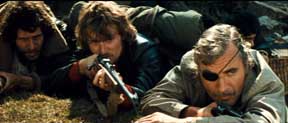
As the film doesn’t contain anything in the way of monsters or other supernatural factors, the horror is not only depicted in man’s inhumanity to others (in a society where all bets are off) but in radio reports of other nations totally collapsing and people resorting to cannibalism (not shown on screen), and even the heroes witnessing the breakdown of the British army as one hostile unit turns on their commander without any semblance of honor. The entire film is well acted, and Davenport is especially well cast, turning in an excellent, understated role as the ex-military officer and family man who takes matters into his own hands despite his proclaimed detest of killing. He murders for survival in an unflinching manner, and the eye-patch he sports is unexplained, but it makes his character more intriguing. Wilde opted to change the book’s elderly sharpshooter/gun store owner into a young “mod” who is a sure shot – it was a good cinematic decision, as Anthony May’s Pirrie is a unique character who is totally unhinged and trigger happy, yet remains loyal to John and never fails to acknowledge him as the leader. Future Hammer star Christopher Neame (LUST FOR A VAMPIRE, DRACULA A.D. 1972) can be seen as the traveler with a pregnant wife.
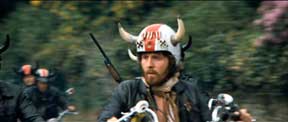 Never
before released on home video, NO BLADE OF GRASS has been nearly impossible
to see, and when TNT aired it in the 1990s, it was panned and scanned and heavily
censored. Warner has now released the film on DVD as part of its ever popular
Archive Collection, and the results of this “remastered edition”
are spectacular. The film is presented uncut in its original 2.35:1 Panavision
aspect ratio with anamorphic enhancement. Picture detail is consistently sharp,
and even with occasional dirt and debris noticeable, the image is largely clean.
Colors are vibrantly beautiful as any early 1970s studio film should be, and
the mono English audio has extremely clear dialog with some hiss detectable
periodically. No trailer is included, which is too bad because it would really
have been nice to see how MGM sold the film to the public upon release. There
are no chapter menu, but chapter stops can be jumped ahead at ten-minute intervals.
(George R. Reis)
Never
before released on home video, NO BLADE OF GRASS has been nearly impossible
to see, and when TNT aired it in the 1990s, it was panned and scanned and heavily
censored. Warner has now released the film on DVD as part of its ever popular
Archive Collection, and the results of this “remastered edition”
are spectacular. The film is presented uncut in its original 2.35:1 Panavision
aspect ratio with anamorphic enhancement. Picture detail is consistently sharp,
and even with occasional dirt and debris noticeable, the image is largely clean.
Colors are vibrantly beautiful as any early 1970s studio film should be, and
the mono English audio has extremely clear dialog with some hiss detectable
periodically. No trailer is included, which is too bad because it would really
have been nice to see how MGM sold the film to the public upon release. There
are no chapter menu, but chapter stops can be jumped ahead at ten-minute intervals.
(George R. Reis)